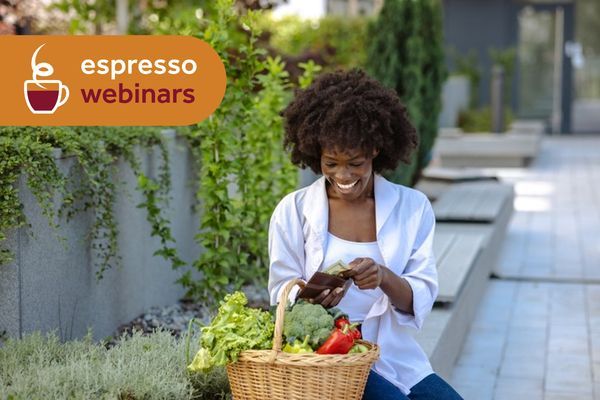To optimise energy and health, the Wellness Solution plate suggests root vegetables and wholegrains make up 25% of your plate, protein makes up 25%, and leafy greens/vegetables are the other 50%.
Good nutrition isn’t just about avoiding ill health - it’s also about optimising health. Aim to:
- eat at least five (ideally seven) different coloured fruits and vegetables every day
- avoid sugary drinks and too much alcohol and caffeine
- include up to two portions of red meat a week, and lean protein sources like fish, eggs, chicken, and vegetables
- eat healthy fats like nuts, seeds, avocados, and olive oil
- replace refined/processed grains with wholegrains and root vegetables
calories/energy
How active you are affects how many calories you need, but, on average, most men need 2,500 calories a day to maintain their weight, while most women need 2,000.
If you want to lose weight, you should eat fewer calories than your body needs. Reducing your daily calories to 1,900 if you're a man, and 1,400 if you're a woman, should result in a safe, sustainable 1-2lb weight loss per week.
But what should we actually be eating?
fruit and veg
Fruit and veg should make up a third of the foods you eat. Five portions a day will help you achieve this and make sure you’re getting plenty of vitamins and minerals.
You could eat them fresh, dried, tinned, or frozen.
what does a portion look like?
- 80g fresh fruit or veg
- 30g dried fruit or veg
- 150ml fruit or vegetable juice
Go for a variety of different coloured fruits and vegetables every day - the darker or brighter the colour, the better.
Vegetables like peppers, tomatoes, beetroot, carrots, and sweet potato, and fruits like blueberries, blackberries, strawberries, and mango, are good places to start.
While both are healthy, fruit is higher in sugar so try to eat more veg than fruit. And remember, potatoes are high in starch so don’t count towards your five a day!
If you struggle to eat five vegetables per day, you could include one or two in a smoothie.
The production of fruit juice and smoothies removes most of the healthy fibre in whole fruit. This means your blood stream absorbs the fructose (sugar) faster.
So try to stick to one fruit juice or smoothie a day. If you drink it before physical activity, it will give you a much-needed energy boost.
If you have children who are fussy eaters, you could blend vegetables into a sauce like Bolognese.
carbohydrates
Carbohydrates, or starchy foods, are your body's primary source of fuel. They’re an essential part of a healthy, balanced diet.
According to Public Health England's Eatwell plate, a third of everything you eat should comprise of starchy foods like bread, oats, rice, potatoes, barley, couscous, and pasta.
what does a portion of carbohydrates look like?
- one medium slice of bread
- two egg-sized potatoes
- three tablespoons of breakfast cereal
- two heaped tbsp rice
Try to choose wholegrain versions wherever possible, as they contain more nutrients and fibre.
why wholegrain?
Any fibre we can’t digest helps us feel full and keeps our digestive systems running smoothly. Wholegrain foods tend to contain higher levels of this fibre.
the two types of carbohydrates:
simple
Simple carbohydrates release sugar quickly and provide an immediate source of energy. They’re an ideal snack before or after the gym to boost your energy levels.
Examples of simple carbohydrates:
- pasta
- rice
- biscuits
- white and wholemeal bread
- fruits without a skin such as bananas and berries
complex
Complex carbohydrates release energy at a much lower rate. This makes them ideal for anyone with a sedentary routine.
Examples of complex carbohydrates:
- seeded or granary bread
- oats
- nuts
- seeds
- beans
- peas and lentils
- sweet potato
- sweetcorn
- fruits with a skin such as apples and pears
skin on or off?
Fruits that have a skin, such as apples and pears, contain more fibre. This slows down the release of sugar. You can slow down the release of sugar by combining fruit with nuts and seeds.
Understanding the difference between simple and complex carbohydrates allows you to use food more efficiently to control your energy levels throughout the day.
It's not just about what you're eating but when you're eating it - do you need that quick release of sugar or are you going to be sitting at your desk for the next few hours?
protein
Protein is essential for building muscle, immunity, tissue repair, and hormone transport.
It also releases sugar slowly, helping you feel fuller for longer and improving your energy levels, mood, and concentration.
Try to eat two to three portions of protein per day. Ideally, it should be the key ingredient of every meal.
If you want to maintain your weight, aim for 0.8g-1g protein per day per kilo of body weight.
For example, 56g-70g protein for someone who’s 70kg/11 stone.
If your goal is to increase muscle mass, increase your protein intake to more than 1g protein per kilo of body weight. You may need more depending on what type of exercise you do.
Eating too much of any food group will lead to weight gain. Excess protein consumption may also cause extra pressure on your kidneys.
To find the right balance for you, always seek professional advice. You can find Registered Nutritional Therapists on the British Association for Nutrition and Lifestyle Medicine website.
why is protein important?
Protein is made up of 22 amino acids, all of which are essential for our bodies. However, there are nine amino acids that our bodies can only find in food.
Meat is a good source of protein, but where possible, choose lean cuts as they’re lower in saturated fat.
Try to avoid red or processed meat like bacon and sausages, which have been associated with certain types of cancer.
Pulses such as beans, peas, and lentils are good options because they're lower in fat and higher in fibre than meat.
However, some only contain small amounts of one amino acid and high amounts of others. So it's important to combine at least two vegan sources of protein a day to ensure your body gets all the protein it needs to perform essential functions.
If you eat fish, you should eat two portions per week, including one oily fish like herring, pilchards, sardines, mackerel, salmon, fresh (not tinned) tuna, and trout. These are rich in omega-3 fatty acids, which can improve your cholesterol levels and are therefore good for your heart.
what does a portion of protein look like?
- three slices of lean meat
- two eggs
- four tbsp cooked beans or lentils
- 120g tuna
- one tbsp peanut butter
milk and dairy foods
Foods such as milk, yoghurt, cheese and fromage frais are sources of protein and calcium, which your body needs to stay strong and healthy.
Use butter and cream sparingly, as both are high in fat and calories.
Fat-free versions contain just as much protein and calcium with less heart-damaging fat and fewer calories.
If you're allergic or intolerant to, or dislike, dairy, you can get calcium from foods like dark green leafy vegetables, sesame seeds, sardines, figs, and fortified soya products.
Aim for two to three portions of dairy every day.
what does a portion of dairy look like?
- 200 ml milk
- one tbsp cream cheese
- one matchbox-sized piece of cheese
- three tbsp cottage cheese
- three tbsp natural yoghurt
- sugar
If you eat too much sugar – either by adding sugar to what you eat and drink or by eating processed foods and drinks that contain sugar, like biscuits, cakes, sweets, chocolate, and colas – cutting down can have a dramatic effect on your calorie intake.
It can also help to stabilise your blood sugar levels, which may reduce your risk of diabetes and heart disease.
natural sugars
Natural sources of sugar, which, while still only needed in moderation, offer a healthy alternative to refined and processed sugars. These include:
- honey
- coconut
- agave
- fruit
Aim to eat one portion of sugary foods a day, like two plain biscuits or a small chocolate bar.
fats
Our bodies need fat for essential cell protection and signalling.
saturated fats
These fats are found in animal products, butter, ghee, margarine, dairy, and other processed foods like pies, pastries, and cakes.
They’re thought to be bad for you because they may increase your cholesterol levels.
Experts recommend men aim for 30g of saturated fat a day, while women aim for 20g.
unsaturated fats
These are in oily fish, nuts, seeds, olive oil, and some fruits and vegetables like avocados. They may lower your cholesterol.
You could swap saturated for unsaturated fats by cooking with vegetable, seed, or nut oils instead of lard, butter, or margarine, and choosing fat-free dairy instead of full-fat.
Always check the nutrition labels on foods - stick to those containing less than 3g total fat per 100g (and less than 1g saturated fat per 100g).
If a food has more than 20g total fat and 5g saturated fat per 100g, avoid it or eat it sparingly.
Grilling instead of frying also uses less fat when cooking.
salt
Excess salt causes your body to retain more fluid, which can raise your blood pressure. And increase your risk of heart disease and stroke.
Try to make sure you eat no more than 6g or one teaspoon of salt a day (3g for children).
salt vs sodium
Some food labels state the amount of sodium in food, rather than salt (2.4g of sodium is the equivalent of 6g salt).
If a label says a product has 0.3g or less of salt per 100g (or 0.1g sodium), it means it's low in salt and you can eat plenty of it.
But try to avoid anything that contains 1.5g or more salt (0.6g sodium) per 100g.
fluids
Our bodies are around two thirds water, so make sure you drink enough for your body to work efficiently and keep you hydrated.
All drinks count towards your daily fluid intake, although water, milk, and low-sugar fruit juices are the healthiest drinks.
are you dehydrated?
Your urine can inform you of how much fluid you need to drink. It should be a pale-yellow colour. If it’s darker, you need to drink more.
alcohol
Too much alcohol can damage your liver and cause high blood pressure and abnormal heart rhythms.
If you drink more than the recommended amount, you could gain weight, too, as alcohol is high in calories. One pint of cider contains around 230 calories.
Drinking in moderation means sticking to current guidelines, which are two to three units a day for women and three to four for men, with at least a couple of alcohol-free days a week.
A unit is one small glass of wine, half a pint of normal strength lager, cider, or beer, or a single pub measure of spirits.
If you have too much to drink, avoid any more alcohol for at least 48 hours to give your body time to recover.
Find out more about how alcohol affects you and how you can keep track of your units by visiting the Drinkaware website.




